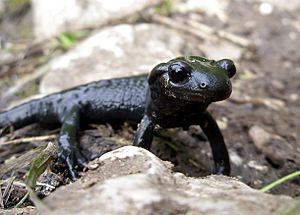Salamandroidea facts for kids
Quick facts for kids SalamandroideaTemporal range: fossil range:
157 mya – present |
|
|---|---|
 |
|
| Salamandra atra | |
| Scientific classification | |
| Kingdom: | |
| Class: | |
| Order: | |
| Suborder: |
Salamandroidea
|
| Families | |
Salamandroidea are a special group of salamanders. They are sometimes called "advanced salamanders." You can find these amazing creatures almost everywhere in the world! They don't live in Antarctica, the southern part of the Sahara desert, or the islands of Oceania.
What Makes Advanced Salamanders Special?
This group of salamanders is known for a unique way they reproduce. Unlike some other amphibians, they use something called internal fertilization. This means the male's sperm meets the female's egg inside her body.
How Do Advanced Salamanders Reproduce?
Advanced salamanders have a unique way of making babies. They use something called internal fertilization. This means the male's sperm meets the female's egg inside her body.
The male salamander creates a small packet called a spermatophore. This packet holds the sperm. He places this packet for the female to pick up. The female then takes the spermatophore into a special opening called a cloaca.
The sperm can be stored inside the female's body. It stays there until she is ready to lay her eggs. This method helps protect the sperm and eggs.
Ancient Salamanders: A Look at Fossils
Scientists have found very old fossils of advanced salamanders. The earliest ones come from a place called the Tiaojishan Formation. These fossils are from the late Jurassic period. That was about 157 million years ago! Finding these fossils helps us learn how salamanders have changed over millions of years.

